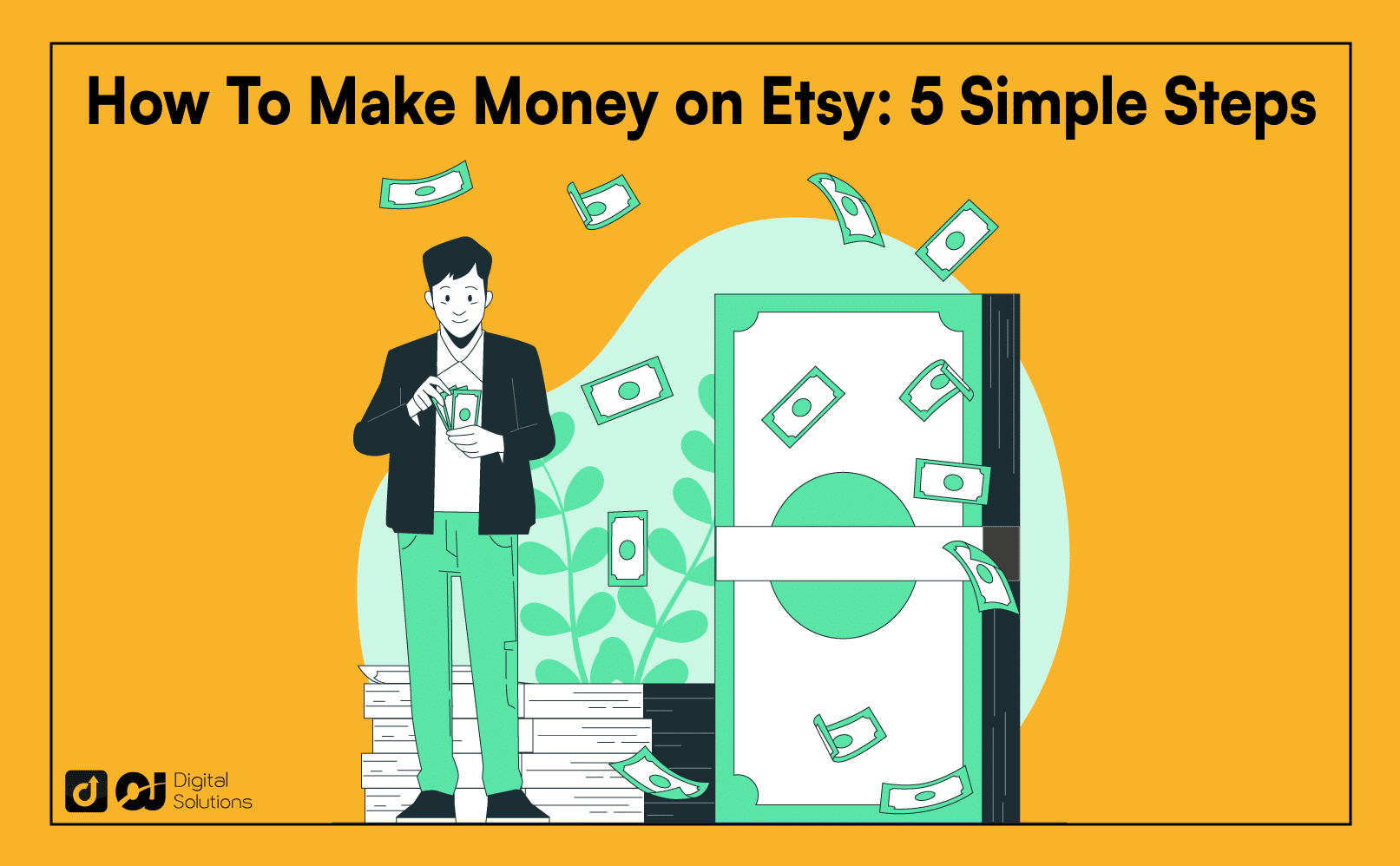Are you looking to turn your passion into a profitable income stream?
Etsy is the right choice. With its robust marketplace and emphasis on unique and artistic products, you can turn a hobby into a side hustle or even a full-time career.
It’s not easy, but I’ll teach you how to make money on Etsy by choosing the right product, setting up an optimized Etsy store, maximizing your listings, and marketing your online store.
I’ll help you understand the importance of knowing your audience, monitoring your competition, and tracking your performance and the latest trends.
Let’s begin.
How Much Does the Average Etsy Seller Make?
Can you make money on Etsy even if you’ve just started? Can you make a living on Etsy if you pursue online selling full time?
Yes. Plenty of success stories are proof you can turn Etsy selling into a lucrative opportunity.
Active sellers can earn between $5,000 to $50,000 annually, depending on their time, effort, product offering, and marketing strategy.
As per Etsy’s 2021 seller survey, the growth merchandise sales of the average Etsy seller was $1,641 in the first year. That figure grew to $2,875 in the second year, $4,090 in the third year, and $6,538 in the fourth year.
Remember, these figures come from aggregate records over a long period. Ultimately, the amount of money you earn on Etsy depends on the effort, time, and strategies you deploy to sell products online.
The success of your Etsy shop also depends on your products. When you’re clear about your offering and who you want to offer it to, it becomes much easier to sell more products online.
Best Ways To Make Money on Etsy: 5 Selling Ideas
The Etsy marketplace focuses on handmade products, vintage items, and craft supplies. However, it has expanded its categories since it first launched, providing more opportunities to make money with Etsy.
You can enter the platform as long as your products align with the idea of handcrafted, unique, and vintage.
Here are some ideas of what to sell on Etsy to make money.

Selling Arts and Crafts
Etsy is the go-to online marketplace for unique, handcrafted products. If you have the talent or skill, you can monetize your hobby.
Some examples are:
Handmade jewelry
Clothing
Ceramics
Candles
Woodwork
Home decor
Leverage your creativity to offer unique products that appeal to your target customers.
Selling Prints and Digital Prints
Do you like painting? You can sell your art on the site, or you can digitize them to maximize their earning potential while you keep the original.
Whether physical or digital art, you can keep selling the same design over and over.
If photography is more your thing, Etsy has a place for you, too. You can sell your photos in digital form, which the buyer can print on their own.
Alternatively, you can offer printed versions of your artwork and photos to ship to your customers.
Selling Printables and Digital Templates
You can make money on Etsy with printables you designed yourself, such as calendars, wall art, notebooks, journals, and more.
Stickers are an extremely popular product on Etsy, mainly due to being an inexpensive way to express one’s individuality. You can design and print stickers for journals, laptops, water bottles, and more.
You can also sell digital downloads on Etsy. You might offer templates, which buyers can customize on their own. Some popular products in this category are wedding invitations, Canva templates, resumes, and social media graphics.
Experiment with various designs and target specific niches.
The best thing about this type of products is you don’t need additional tools or equipment. All you need are an iPad or computer and photo editing software.
I recommend Canva and web-based tools you can use for free. If you want extensive features, go for subscription-based software like Adobe Photoshop and Canva Pro.
Dropshipping and Print-on-Demand Services
Dropshipping and print-on-demand (POD) services allow you to sell on Etsy without having to manage inventory and fulfillment. In theory, you can run a successful Etsy shop without investing in products and spending time on packaging and shipping orders.
Here’s a quick look at how Etsy dropshipping works:
You find a supplier for an Etsy-approved product and list them on your Etsy storefront.
A customer orders from you.
You forward the order details to the supplier.
They prepare the order and ship directly to the customer.

Print-on-demand services can usually integrate with your Etsy shop, which means all orders automatically go to them. The platform then prints the order and ships it to your customer with no additional input from you.
You only have to sign up on their platform, upload your designs, and manage any inquiries and issues. You can then focus on creating designs, providing excellent customer service, and marketing your shop.
However, it’s by no means an easy way to make money on Etsy. Your Etsy print-on-demand business still depends on you.
Selling Custom Orders
Etsy is the home of personalized items.
Shoppers seek this type of products to accommodate their specific needs and preferences. They also like the individual touch it adds to an otherwise generic item.
Selling custom orders requires more effort but has a high earning potential. You can offer custom jewelry, engravings, custom-designed fashion accessories, and more.
How To Make Money on Etsy: Step-by-Step
Ready to get started on making money on Etsy?
Here’s how to sell on Etsy and make money.
Step 1: Choose a Niche and Product Category.
Research High-Demand and Profitable Products.
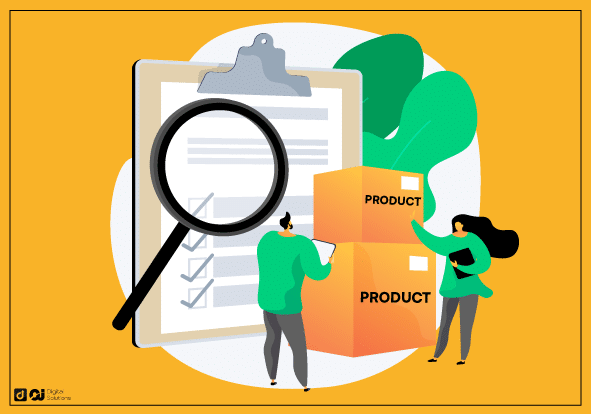
Start your Etsy journey by identifying profitable products that aligns with your skills, interests, and market demand.
If you’re the creative type, you already likely have a good idea of what you want to sell. You can then research the demand for it and ways to monetize it.
Otherwise, you can explore different categories to understand the trends and popularity. Visit different shop pages to see what speaks to you.
Keep an eye on market gaps, which you can capitalize to set yourself as a trendsetter. Look for ways to add a unique spin to an existing product, or target specific niches.
Understand Your Target Audience.
Etsy provides the perfect opportunity to turn your passion into a stream of income. However, it doesn’t mean you can simply start uploading your work to the platform.
You must first understand what the audience wants. If there’s no demand for your offering, you won’t make any money.
You can use product research tools like Everbee and EtsyHunt. They can help you determine the search volume for a particular keyword. If enough Etsy users are searching for the keyword, it means there’s demand.

Research your market, as well. Identify the interests, demographics, and preferences of your potential customers.
Knowing what your audience wants helps you tailor your product offerings and marketing strategies to attract the right market.
Research Competitors and Define Your USP.
While doing your research, check out the amount of competition and what successful shops are doing.
You don’t necessarily have to ride the waves of a massively popular product. It would be harder to stand out.
Similarly, don’t get discouraged from high competition. It means there’s money in this niche, but you must find creative ways to be distinctive.
An artistic product sells well when they have a unique personality. Ask yourself what you can create to stand out from other products in the same category.
How can you take their product and offer something better? This should be something that adds value to the customer and not simply a gimmick.
Define your unique selling proposition, and add a unique personality to your art. Etsy customers are always looking for something creative, so let your creativity show through your work.
Calculate How Much You Can Potentially Make.
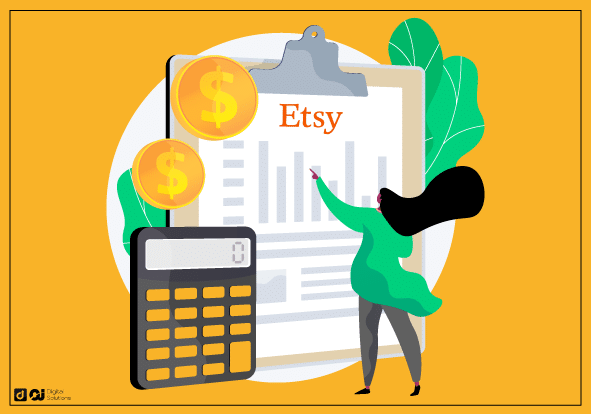
Etsy charges sellers some fees to keep the site going, just like other online selling platforms.
If you want to know how to make a profit on Etsy, consider Etsy’s fees, such as:
Listing fee – $0.20 per upload or renewal
Transaction fee – 6.5% from every sale, including shipping and gift wrapping costs
Payment processing fee – varies
Etsy advertising fees (optional)
You must also factor in the other associated selling fees, such as:
Production cost – tools, equipment, and materials
Packaging cost – shipping boxes, packaging materials, branding
Shipping cost – shipping label, courier rates
Monthly fees – subscriptions, rent (for storage, workspace, or inventory, if applicable)
You must also consider the taxes and work them into your pricing.
Once you factor all these considerations, you can see how much to charge to earn a profit from each sale.
Create a Quality Product.
Many Etsy sellers might promise beautiful products, but the question is: are they of good quality?
Quality isn’t just aesthetics. It also depends on the material and level of skill that goes into making it.
In general, offer something durable. If you’re selling digital items, ensure your delivered files are high resolution.
Set an Appropriate Price.

Etsy shoppers are a bit unique in that they look at the product’s value rather than the price.
Etsy is an online marketplace that places high value on unique and handcrafted items, which sets expectations about pricing. Etsy products are usually one-of-a-kind, and customers are willing to pay for them.
While they will still look for a bargain, understand that they can be willing to spend as long as your product’s perceived value justifies the pricing.
Aside from considering your costs, consider the competing Etsy stores, too. How much are they pricing similar products?
This gives you a better idea of what is a reasonable price for your products and customers.
Lower – your product will be competitive, but buyers might assume it has lower quality.
Higher – buyers will associate a higher price tag with better quality or higher value, but it might discourage potential customers on a budget.
Find the right balance, and ensure your product can justify its pricing.
What Products Can’t You Sell on Etsy?
Not all products are allowed on Etsy. If your product falls into these specific categories, you cannot sell it would be best to sell them on your website.
Prohibited items include the following:
Tobacco products
Drugs or drug paraphernalia
Weapons
Hazardous materials
Items that use someone else’s intellectual property
Step 2: Set Up Your Own Etsy Shop.
Check If You Need a Business License.
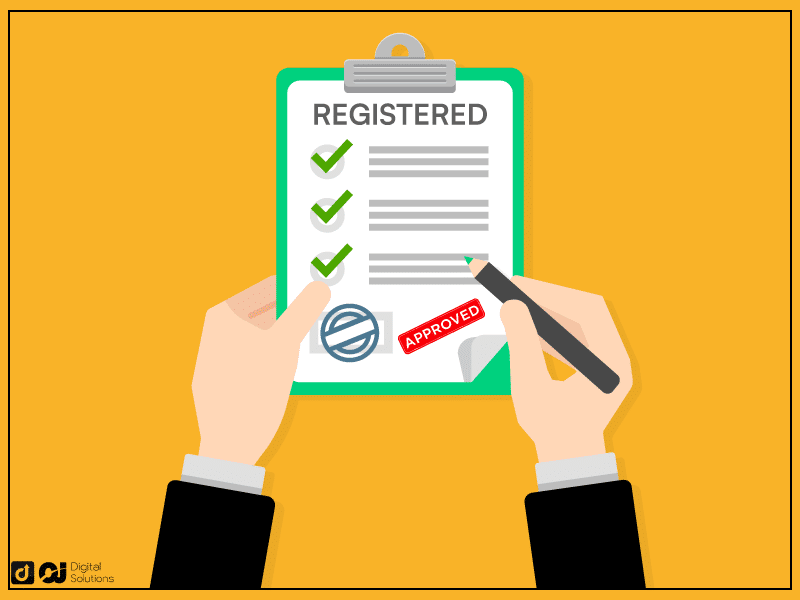
Do Etsy sellers need a business license?
While Etsy doesn’t require one when you sign up, you must still check with your local laws and regulations.
For the IRS, your Etsy shop needs a business license as long as you’re treating it as a business, not a hobby. Some cities and states don’t require one.
You may also need additional permits, depending on the products you sell and how much you’re selling.
Rules and regulations about licenses, permits, and taxes vary depending where you live. Check with your local government authorities or consult a legal professional.
Create Your Etsy Store.
To create an Etsy store, head to Etsy.com/sell and click Get Started.
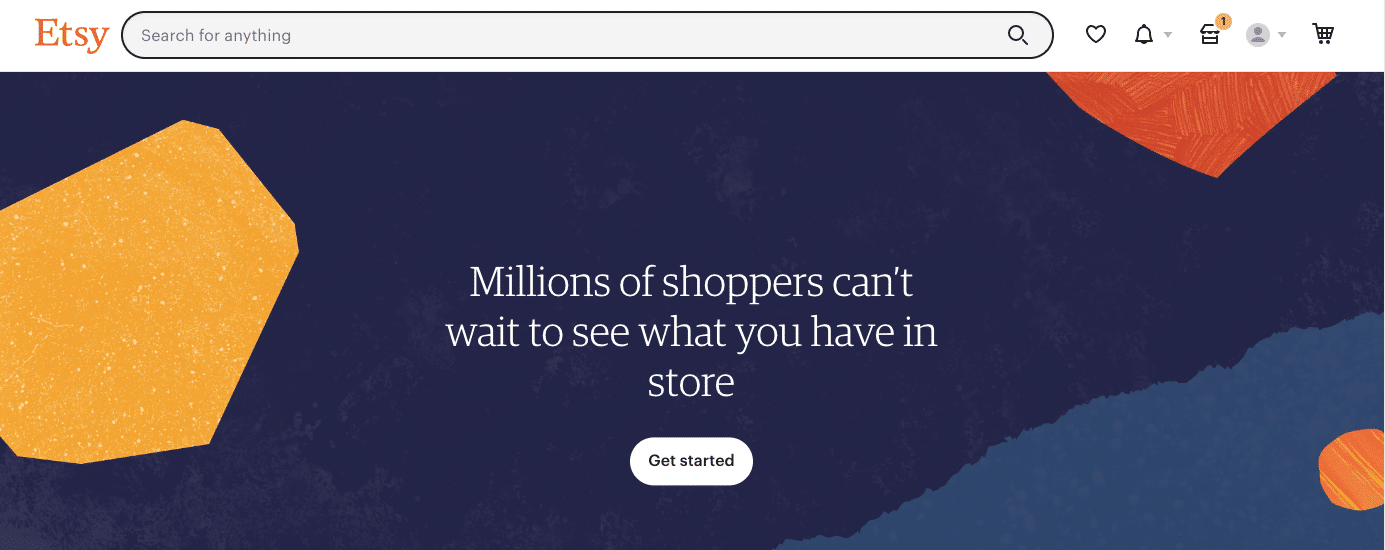
Follow the succeeding prompts. You’ll have to choose your Shop Preferences, like your shop language, country, and currency.
Next, you must enter your shop name. Don’t worry too much about it, you can also change your Etsy shop name later.
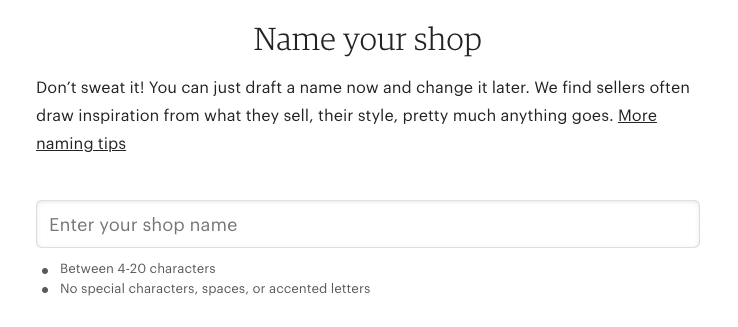
Your Etsy shop name should follow a few simple rules:
The name should have between 4-20 characters.
Your name should have no spaces or special characters.
Profanity in the name isn’t allowed on Etsy.
You should use a name that other Etsy shop owners haven’t used yet.
Your name should not infringe any trademarks or copyrights.
Set Up Your Payment and Billing Details.
You must connect a bank account to your Etsy shop to receive payments from Etsy.
The information you need to enter depends whether you’re registering as an individual or a corporation. In general, you must provide the following information:
Full name or business name
Address
Shop country
Date of birth
Phone number
Last four digits of your social security number

Etsy will then ask for your credit card information to pay for Etsy’s fees.
Set Up Your Storefront.
After you’ve set up your Etsy account and payments, you’ll need to set up your storefront to show your items for sale. Add a photo to your account to make it more legitimate looking.

Add your shop logo and banner to customize its look and establish your branding.
Typically, shop pages will also include considerations like production time (if you’re pre-selling handmade goods), store policies, and shipping arrangements. So, you should consider adding those in too.
Offer Free Shipping (Highly Recommended).

Most ecommerce shoppers nowadays expect free shipping. Many will go out of their way to get a free shipping coupon, like adding more items to their cart to meet the minimum requirement.
Etsy understands this isn’t always possible for small businesses. That’s why it has tools to help you calculate the shipping costs.
But to give you an idea, here are some ways you can offer free shipping:
Factor the shipping costs into the product price.
Set a minimum order price.
Bundle your products.
Step 3: Optimize Your Etsy Product Pages for Conversions and SEO.
Invest in High-Quality Product Photos.
Once you have your store and products ready, take nice photos of your products. The quality of your photos is a driving factor in bringing more sales.
Use high-quality photos that showcase your product’s best features. Use natural lighting as they’re easier on the eyes and more enticing.
If you’re selling digital downloads, create a mockup. For example, place an image of your digital prints on a frame mockup on a wall. This will help buyers visualize the artwork once printed.
Ensure you’re following Etsy’s listing photo size requirements. This helps you optimize your webpage and improve customer experience.

Write Persuasive Product Descriptions.
On top of great photos, your Etsy store will also need good copywriting. Take the time to lay out your Etsy product’s specifications, benefits, and terms.
Provide any information your buyers need to know. State how it can solve their problems, and set the right expectations for your product.
However, don’t overpromise or inflate your product’s benefits. Your buyers might feel deceived and affect your store’s reputation.
Do Keyword Research and SEO To Improve Your Visibility.
The foundation of your marketing strategy is keywords. These are the words and phrases that Etsy users type into the search bar when looking for a product like yours.
The Etsy search algorithm looks for product listings that match the user’s intent, and displays them on the search results page.
It takes several considerations to calculate the listing quality, but this is the main idea:
The more relevant your listing is to the user’s search, the higher it will appear on Etsy’s search results. A higher ranking means more visibility.
How do you find the right keywords? You can use Etsy SEO tools like EverBee and EtsyHunt, which shows data like search volume, competition, and more.

Once you find the best keywords, incorporate them into your listing, particularly in these components:
Title
Description
Tags
Image file name
Image alt text
These keywords must be relevant and naturally incorporated. Avoid keyword stuffing and simply listing all the keywords you find; you might get penalized instead.
Start Adding Product Listings.
Now that you have your own Etsy store and products to sell, start creating listings. Here’s how to do it:
1- Go to your Shop Manager.

2- From the left panel, click on Listings.
3- Select + Add a Listing to start creating a listing.

Ensure you incorporate our previous tips, like using the right photos and optimizing all your listing elements for the search engine.
You must also provide clear shipping and returns policies to encourage visitors to buy.
Step 4: Promote Your Etsy Store.
Choose a Marketing Channel.

Researching your target audience should allow you to discover what platforms they commonly use.
Are they on Facebook? What blogs are they interested in? What pages do they follow on social media?
Create a list of their platforms and interests, then figure out how to make a presence there.
Here are some free marketing channels you can use:
Social Media
You can engage directly with your audience by creating a presence on social media. You can post reels, images, videos, and ads to widen your reach.
Email Marketing
Email marketing campaigns help you maintain direct communication with your customers. You can send newsletters, personalized deals, and valuable content, which help you foster brand loyalty and brand recognition.
You can also leverage paid methods, such as:
Etsy Ads
Etsy has built-in advertising solutions to help you boost your listing’s visibility. By targeting the right keywords, you can get your products at the top of the search results, ensuring they’re the first things that searchers will see.
Online Advertising
Captivating ads can help drive traffic to your store. Some options are Google ads, display ads, social media ads, and video ads.
Influencer Marketing
Influencers typically have a wide reach. They can help you market your Etsy shop to their audience using sponsored posts, giveaways, affiliate links, and other strategies. However, you must ensure their audience aligns with yours.
Collaborations
You can also team up with other Etsy sellers to hold selling events. The Etsy community regularly finds smart ways to save, such as sharing costs for professional marketing services like photoshoots and campaigns.
Ensure you don’t spread yourself too thin. Focus on one to two marketing channels while leaving room for possible expansion in the future.
When choosing, consider your time and budget. For example, you can pay for ads or influencers if you have more money but not too much time.
Conversely, if you have more time and a lower budget, focus on building an organic following on social media.
You can also use free website builders like Shopify for more marketing possibilities. Having your own website allows you to build your brand more freely.
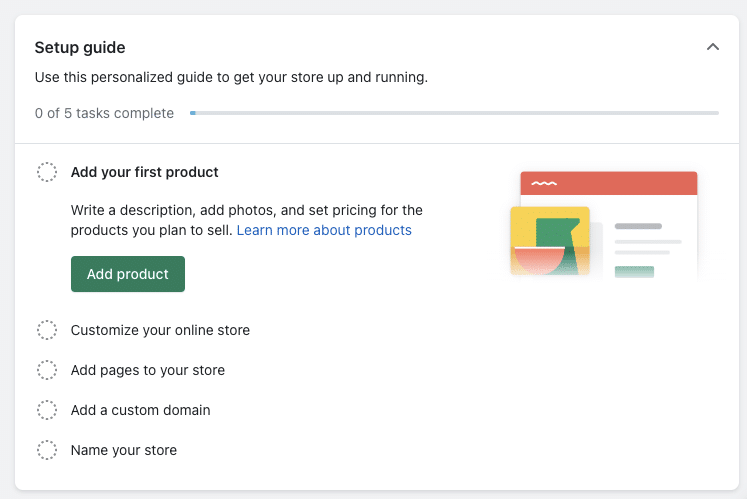
Shopify has features unavailable on Etsy, like adding an About Me page or a blog to unlock content marketing. This allows you to target traffic from Google and other search engines.
You can also design a landing page for your email marketing strategy. You can collect emails on Etsy with free tools to foster customer relationships, encourage sales, and collect feedback.
If you have extra money, feel free to expand your website’s features and improve the user experience.
Create Your Social Media Profiles.

Creating social media profiles on various platforms is a great way to build your presence and reach your target audience.
Choose an online platform where your audience typically hangs out. Some popular options include:
Facebook
Instagram
Pinterest
Twitter
TikTok
LinkedIn
Consider creating a YouTube channel where you might show your creative process if you’re selling artwork and handmade items.
Instagram and Facebook Reels are the most popular forms of content today, perfect for behind-the-scenes and short, relatable videos.
Drive your social media followers to your Etsy listings by leaving links to your store or products in the caption area. On Instagram, place a link to your store in your profile bio.
Offer Solid Customer Service To Get Your First Positive Reviews.

When running an online business, your existing customers are your best contacts. Studies show that returning loyal customers spend about 33% more on your products than new ones.
Keep close contact with customers and answer their queries as soon as possible. You can also post the usual hours you respond to follow-ups and questions.
Solid product offerings and excellent customer service can help you get your first reviews. Positive reviews increase social proof, giving new customers the confidence to buy from your store.
Develop a customer feedback strategy to encourage your buyers to share their experience. Just be sure not to seem too demanding, as it’s against Etsy’s rules.
If you get negative reviews, don’t let them get you down. They’re bound to happen.
When they do, respond politely to the customer and find a way to make things right if possible. Use this opportunity to identify your weaknesses and improve.
Step 5: Monitor Your Performance and Adapt.
Have you got everything covered? It doesn’t end there.
You must constantly monitor your shop’s performance after implementing your strategies. Gather your shop’s analytics and data from your marketing efforts.
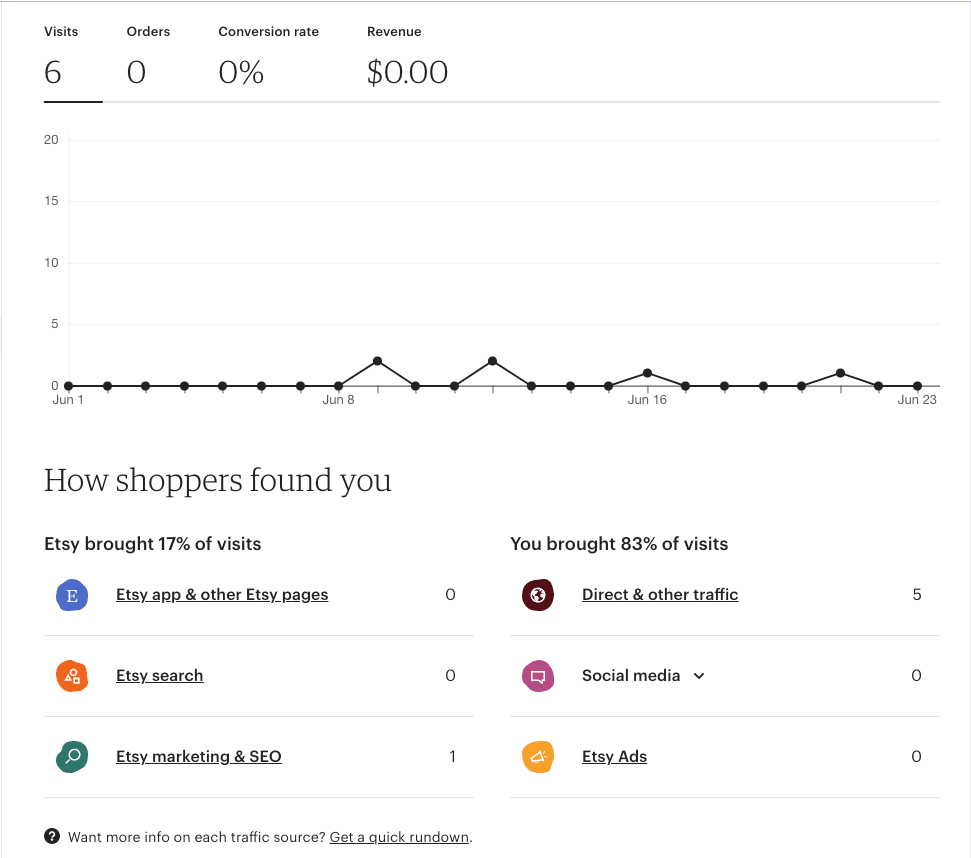
By data, I mean:
Customer Reviews.
Assess your customers’ satisfaction level by reading your reviews. Look for recurring issues you can improve, and identify your strengths based on what your customers like.
Ad Reports.
Suppose you’re running ads – track metrics like ad impressions, clicks, click-through rates, and conversion rates. Analyze which ads are generating the most engagement and conversions.
Traffic Volume and Sources.
Etsy provides data like how many customers visit your shop and where the traffic comes from. Keep an eye on any spikes or declines, and understand where your audience is coming from to know where to focus your marketing efforts.
Sales and Conversion Rates.
These metrics directly result from your marketing strategies, indicating whether they work. For example, a good conversion rate means your strategy is working.
You should also analyze each product’s performance to identify your best-sellers and items needing improvement.
Social Media Reports.
If you promote on social media, monitor metrics such as reach, engagement, click-through rates, etc.
Keyword Performance.
Use Etsy keyword tools to monitor the keyword performance, allowing you to see which generates views, clicks, and conversions. Look for opportunities to optimize your Etsy SEO strategy.
Market Trends.
Stay on top of the latest trends on Etsy and in your niche. Follow industry news and monitor your competitors’ activities, allowing you to adapt your strategies and stay ahead of the competition.
Take ALL that data, then assess your situation and adjust accordingly.
Rinse and repeat.
The Etsy marketplace and your audience’s needs are constantly evolving. To be a successful Etsy seller, you must be open to adapting your strategies and experimenting with new techniques.
Frequently Asked Questions (FAQs)
What Sells Best on Etsy?
Etsy has three main categories: handmade items, vintage products, and craft supplies. Among these, the biggest categories are:
Home and living
Art and collectibles
Jewelry
Clothing
How Long Does It Take To Make Money on Etsy?
In general, a new Etsy store can make the first sale in one week to one month. However, it depends on several factors. It might take you a few months, or you can land a sale on your first day. What matters is you stay focused on your goal to start making money.
Can a Beginner Make Money on Etsy?
Yes, beginners can make extra money provided they do due diligence. Ensure you follow our tips above for choosing the right product, optimizing your listings, and marketing your Etsy shop.
How To Make 6 Figures on Etsy?
If you want to know how to make 10k a month on Etsy, follow these tips:
Review the Etsy seller handbook to know the platform’s rules and regulations.
Take the time to research your market.
Identify the right products to sell.
Use Etsy search engine optimization strategies.
Optimize your product listings.
Promote your Etsy shop.
How Much Does Selling on Etsy Cost?
Selling on Etsy incurs the following costs:
Listing fee
Transaction fee
Payment processing fee
Optional advertising costs
The Bottom Line
Congratulations! You now know how to set up an Etsy business and make it grow.
The first step is always the hardest. So take that step today and follow the steps I provided to start selling on Etsy.
What kind of products would you like to sell on Etsy?
Remember my tips to ensure a successful Etsy business for the long-term.

